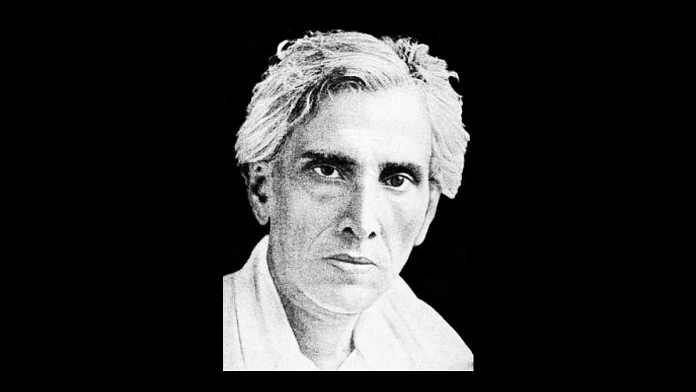West Bengal was responsible for several writers and novelists who propelled India’s nationalist movement in the pre-Independence era. Each contributed through their words, penned as scathing remarks to an unequal society in need of social reform. In that chapter of Indian literature, Sarat Chandra Chattopadhyay remains one of the most revered names.
On his 81st death anniversary, ThePrint takes a look at the work of the Bengali novelist who gave Indian literature some of its most well-defined women characters.
Early life
Born on 15 September, 1876, in West Bengal’s Hooghly district, Sarat Chandra knew poverty from an early age due to an idle father. He studied at a village school, and was forced to drop out of college due to his limited means.
Some of his surviving childhood works include Korel and Kashinath.
At the age of 27, he shifted to Rangoon (now Yangon, Burma) as a clerk in a government office in 1903 and published his first short story Mandir that won him the Kuntolin Puraskar. He stayed in Rangoon for the next 13 years.
On his return to Bengal, he became a favourite among magazine readers for his contributions in Jamuna and Bichitra. He also wrote under two pseudonyms — Anila Devi (his sister) and Anupama.
Fame came easy after this but only made Sarat Chandra reflect deeply on the political and social scenario at large and comment on them through his stories.
Also read: Cats that wink & science of comets: Sukumar Ray’s fantastic world of literature and creatures
Portrayal of the fallen woman
Sarat Chandra is hailed as one of the greatest novelists in Indian literature to have penned contemporary women. Some of his iconic female characters are Paro in Devdas (1917), Vijaya of Datta (1917-1919), Hemangini of Mejdidi and Kamala of Shesh Prashna (1929). His women spoke their mind and did so without any fear of society’s ire.
For instance, in Shesh Prashna, Kamala dismisses the Taj Mahal as a monument that satisfied an emperor’s ego, instead of the conventional ‘monument of love’ line of argument.
He wrote his women as outspoken at a time when they were confined to their homes, even as West Bengal was witnessing social movements for women’s remarriage, education and greater freedom.
Some of his celebrated works saw him telling stories centered around the fallen women. He told their stories in Charitraheen (1971), Devdas and Srikanto (published in four parts between 1917 and 1933) even if it meant censorship. His women exuded strong will of mind and heart despite the society’s view of them.
The iconic Chandramukhi, a baiji (courtesan) in Devdas, was a downtrodden woman for society but Sarat Chandra chose to tell her tale of unrequited love. His women never bowed to societal norms and even if they did, it was always out of their choice.
Also read: Dilip Kumar Roy, the Cambridge-educated elite who added melody to India’s freedom movement
The Bankim-Sarat-Tagore trio
Two of the tallest Bengali litterateurs of his time were Bankim Chandra Chattopadyay and Nobel laureate Rabindranath Tagore.
Sarat Chandra’s writing from an early age showed influences of Bankim Chandra Chattopadyay, who also stood against Hindu orthodoxy — social injustices and superstitions.
However, Sarat Chandra demarcated himself with his easy writing, pitched as high drama, that rested more on colloquial language unlike the harder to read Bankimi Shadhu bhasha, a sanskritised version of Bangla.
Sarat Chandra’s pedigree was also in stark contrast to that of Tagore. While both wrote on social inequality, poverty, and caste issues, Sarat Chandra for most part had lived in poverty, unlike Tagore who had only observed it from a distance.
A favourite for screen adaptations
Sarat Chandra’s dynamic characters made his novels a favourite for screen adaptations across various languages.
Devdas alone has seen over 16 versions on screen with Sanjay Leela Bhansali’s Shah Rukh Khan-starrer Devdas (2002) introducing the novella to a younger crowd.
Parineeta too was adapted by Bollywood in 2005.
Others included Apne Paraye (1980), based on Nishkriti (1917), Gulzar’s Khushboo based on Pandit Mashay, Datta (1976) based on the novel by the same name. Srikanta was adapted for screen as Iti Srikanto in 2004. It was adapted by Doordarshan in a series, Shrikant (1985-86), starring Farooq Sheikh, Sujata Mehta and Irrfan Khan.
Personal life
After the death of his first wife and son due to plague, Sarat Chandra married an adolescent widow.
At the age of 65, he was diagnosed with liver cancer and died on 16 January 1938 in Calcutta (now Kolkata).
Decades after his death, Sarat Chandra’s characters continue to live on in print and celluloid with their contemporary and captivating nature, adding to the country’s understanding of itself.



